13 Of The Best Types Of Bread For Breakfast Sandwiches
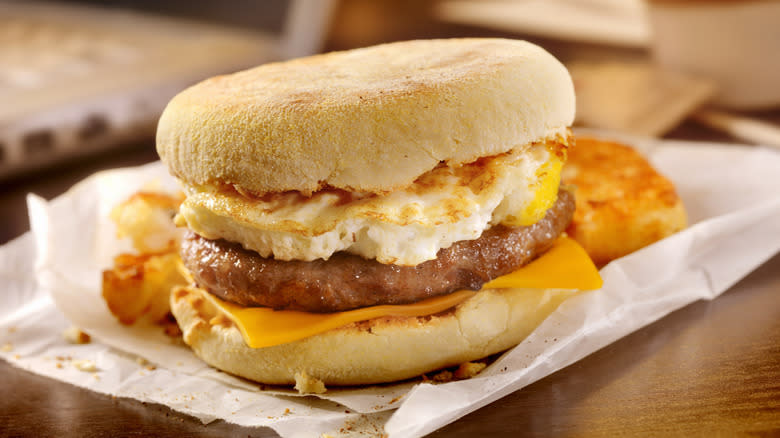
In my nearly 18 years as a professional chef, and owner of a bed and breakfast and a fine dining restaurant, I have learned a thing or two about the science of crafting the perfect breakfast. One such breakfast that made a regular appearance on my menu was the breakfast sandwich. Though the breakfast sandwich comes from humble origins, it has recently experienced a renaissance. Chefs like me have taken the rustic idea of a quick, affordable, on-the-go breakfast and elevated it into a gourmet delight.
Your choice of bread is one crucial factor in creating a delectable breakfast sandwich. Though you can technically use most bread types, some are more well-suited to this task than others. If you have ever eaten a juicy burger, you may have experienced a bun that disintegrated as you bit into it, spilling the insides all over your favorite white top. If this has happened to you, you will understand the importance of bread selection in the breakfast sandwich.
The perfect breakfast sandwich must be made from bread that can withstand hearty ingredients without falling apart. It must also be relatively easy to bite into. Its flavor should even complement the fillings without overwhelming them or contradicting them. Read on for all the details on the best types of bread for your breakfast sandwich and how they made the cut, in my professional estimation.
Read more: 12 Underrated Types Of Fish You Should Try At Least Once
English Muffin
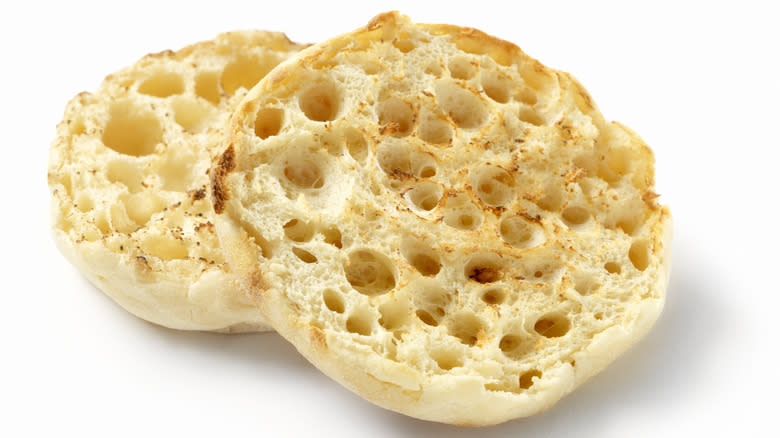
The English muffin is among the most well-known bread types used for many store-bought and fast-food breakfast sandwiches. Though some muffins similar in texture and flavor were once commonplace in England, the iteration we all know and love was not invented there. They were actually the brainchild of British ex-pat Samuel Bath Thomas, who began making them in America in the 1880s, eventually trademarking the "English muffin" moniker in 1926.
While the original English muffin recipe was based on a classic English crumpet, it is flatter, and baked on both sides rather than just one, preserving those characteristic nooks and crannies within the bread rather than atop it. The English muffins were also "fork split," which means they underwent a process that made them easier to separate and toast. This process has since become mechanized but is no less crucial to the popularity and efficacy of the English muffin for making breakfast sandwiches.
Other factors that make the English muffin so ideal as a breakfast sandwich vessel are its capacity to become firm yet supple when toasted, enabling it to hold its shape even when juices from meat, eggs, and gooey cheese seep into those nooks and crannies. It also has a relatively mild flavor that can accentuate sweet and savory fillings. Lastly, the English muffin is the perfect size for a hearty yet sensible breakfast that easily fits into one hand.
Sourdough
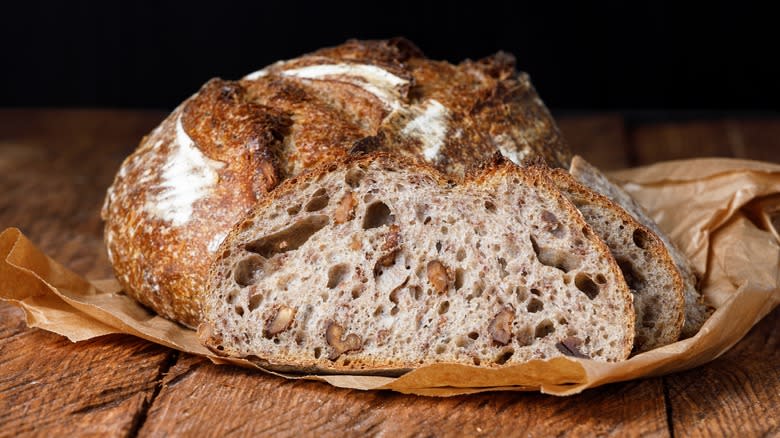
Sourdough is a type of bread that has seen something of a resurgence. During the lockdowns associated with COVID-19, many people took to baking as a way of passing the time and dealing with anxiety. Social media threads across numerous platforms were then filled with photos of people feeding sourdough starters and showcasing freshly baked loaves of bread.
There is a lot to love about authentic sourdough bread. It has a distinctive flavor and texture, conferred by the activation of wild yeast during the fermentation process of flour and water. Not only is this flavor desirable, but the bread itself may be better for you than other varieties. It is suggested that those with digestive issues may be able to tolerate sourdough due to its lower levels of fructan, and its decreased levels of phytic acid may improve its nutrition content.
The health benefits of sourdough bread alone are enough to use it for your next breakfast sandwich. That said, sourdough also has a marvelous texture that is robust enough to withstand extra juicy fillings without dissolving and has a chewiness that is certain to satiate every appetite. Lastly, its distinct tart flavor is a delightful contrast to fatty, salty, umami-rich ingredients.
Bagel
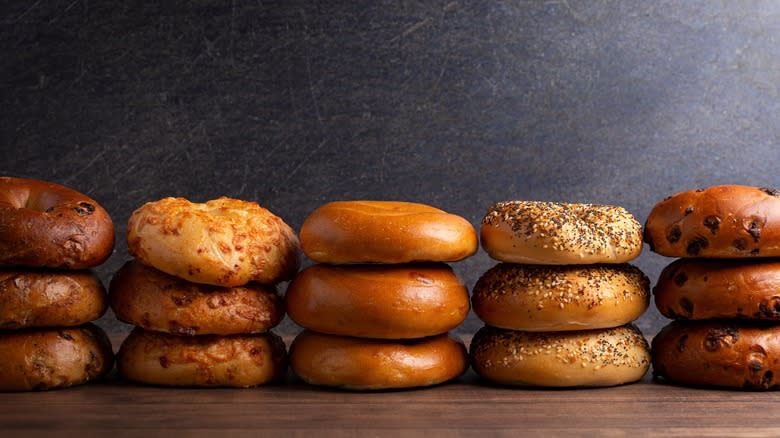
The demand for the bagel as the base for breakfast sandwiches of all ilks is hard to deny. This humble, hole-y, Jewish staple has a lengthy history dating back to Poland in the 1500s. Among the many things to know about the bagel is that it was brought to the United States by Eastern European Jewish migrants who fled to America in the early 1900s. It was popularized by Murray Lender of Lender's Bagels fame during the mid-20th century.
A quality bagel has a couple of distinct characteristics. First, it has an impossibly tender interior, juxtaposed by a chewy-yet-crunchy crust obtained by boiling and baking the bagel. The other characteristic is its signature hole in the middle. This produces more surface area exposed to the oven's heat, allowing the bagel to bake faster while giving it a higher crust-to-center ratio.
The sky's the limit when using a bagel for a breakfast sandwich. Since bagels come in sweet and savory flavors, you can use fillings of both types to stuff them. The hole in the middle may produce another issue: the fillings falling through. Creating a barrier between the bagel and the juicy layers is the solution. Lettuce, meat, or fruit can be placed on the bottom and top of your sandwich, keeping all that luscious filling where it belongs.
Brioche
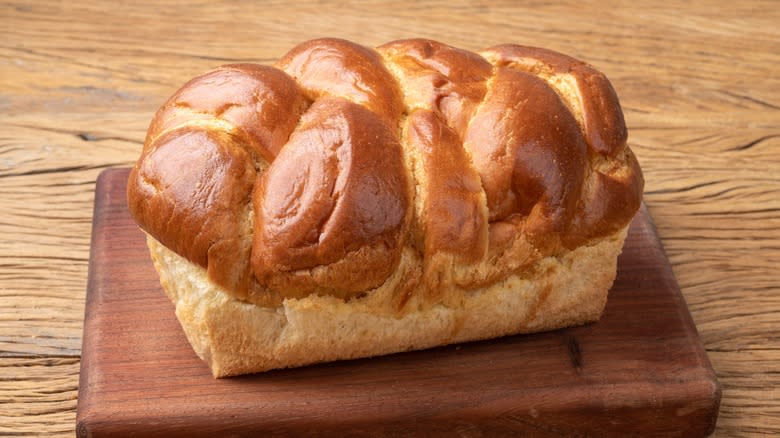
Brioche often tops the list of the most commonly recommended types of bread for French toast. The things that make brioche so desirable for French toast are also characteristics that make it so well-suited to being used for a breakfast sandwich. The unique, rich, tender, and flaky texture of brioche gives it the capacity to absorb moisture while remaining intact -- especially when toasted. The sweet yet savory flavor is ideal for countless breakfast sandwich recipes, from croque madames to Monte Cristos.
People often wonder if brioche is a bread or cake thanks to its unique taste and texture. The short answer is it is neither. It is classified as what is known as a viennoiserie. Viennoiseries are characterized by their status as an enriched dough. Unlike traditional yeast bread, viennoiseries are elevated by ingredients like butter, milk, eggs, and sugar. Brioche often contains sugar, eggs, and abundant amounts of butter. The added fat not only imparts flavor, but by decelerating the fermentation process of the yeast, it shrinks the gluten strands within the dough, lightening the dough and making it flaky. Lastly, the added sugar in the dough helps brown the bread, giving it a crispy crust to balance juicy fillings.
Challah
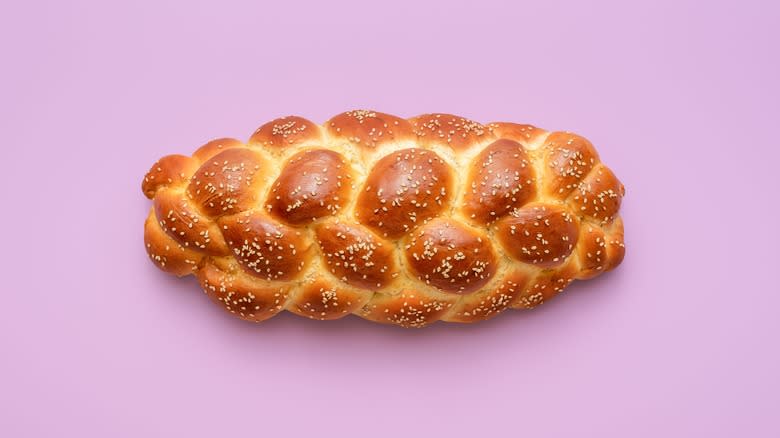
Another type of bread highly favored for making French toast is the close first cousin of brioche: the classic Jewish challah. Challah is best known for its unique patterns and shapes woven from pieces of dough. Similarly to brioche, challah is also considered an enriched bread or viennoiserie. It is often produced using eggs, oil, and occasionally sugar.
The interior of challah has a fluffy, flaky texture that is perfect for absorbing juicy ingredients. The exterior crust is golden and shiny and has a chewy-yet-crisp mouthfeel that helps to hold the bread together even when layered with more robust fillings. The flavor is sweet and savory, with an intense richness conferred by the eggs used in most recipes.
This complex flavor makes it ideal for pairing with virtually any breakfast sandwich filling, from eggs and cheese to ricotta and honey. Challah comes in several varieties, with some having toppings like sesame or poppy seeds that enhance the crunchy texture of the crust, particularly when the bread is toasted.
Biscuits
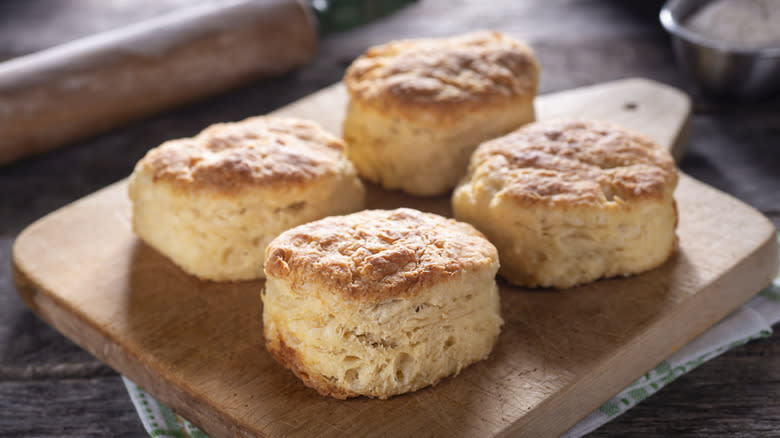
The rustic biscuit is another bread that appears frequently in recipes for breakfast sandwiches. The flaky, pull-apart, rich interior and hearty crust of a biscuit is capable of withstanding hefty and moist fillings while retaining a tender mouthfeel. Its slightly tangy flavor complements sweet and savory ingredients, giving it great versatility in building a better breakfast sandwich.
The key is using a high-quality biscuit. Though there are many store-bought options, making your own is simple if you know the pitfalls to avoid when baking biscuits. Adding buttermilk to the dough is among the most crucial factors in baking a brilliant biscuit. The acidity in the buttermilk helps to leaven the dough, giving it that fluffy texture. It also provides that delightful tanginess that helps balance fattier or spicy ingredients added to your breakfast sandwich.
And don't forget to use cold butter. This is the key to creating those distinctive layers within the biscuit that will absorb all those yummy juices and gooey cheese. Steam is released as the butter melts in the oven, helping to puff up the dough. You can also use lard or shortening, though the flavor and texture will differ slightly.
Croissants

The croissant is another bread commonly used as the base for a breakfast sandwich. Few types of bread inspire the imagination like a flaky, golden, luxurious croissant. This crescent-shaped bread, which originated in Austria and was popularized by the French in the mid-1800s, is characterized by hundreds of layers of dough. These layers are produced using a technique known as lamination.
The lamination technique involves alternating rolling cold pieces of butter into an enriched yeast dough and folding it. Repeating this process several times infuses the dough with pockets of cold butter that can evaporate during baking, fluffing it up, crisping it, and yielding the quintessential honeycomb texture of a croissant.
These layers of flaky dough and the complex honeycomb network act as a sponge, absorbing juices from any ingredient layered upon a croissant. The caramelized, shiny crust has a delicate yet firm texture that enables it to hold together while being easy to bite. And the impossibly buttery flavor compliments sweet and savory fillings alike. When toasted, these features make a croissant a perfect, elegant option to use for a breakfast sandwich.
Tortillas
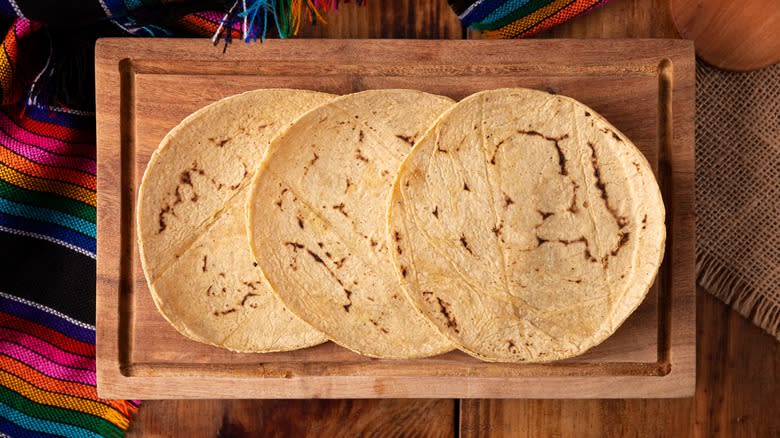
The humble flatbread known as a tortilla may not seem to fit the criteria for being a suitable option to build a better breakfast sandwich, because of its thin and often delicate texture. That said, one need not look further than a classic huevos rancheros to know this is untrue.
These little cakes have been a staple of the Mesoamerican diet for thousands of years. An authentic tortilla is fashioned from corn kernels soaked in lime and water before they are pulverized and formed into a dough, a process called nixtamalization. The resulting dough is shaped into orbs before getting flattened onto a hot grill or comal and cooked.
Though this process has been mechanized and tortillas are now made from all kinds of grains, the characteristics of a tortilla remain. They can be wrapped, folded, rolled, or layered to create endless recipes. You can eat them as-is, warm them, or fry them until they are crisp. When delicately handled and expertly layered, they can become the perfect delivery method for sweet or savory ingredients. The superpower of the tortilla is its versatility, which translates to making a dynamite breakfast sandwich.
Kaiser Roll
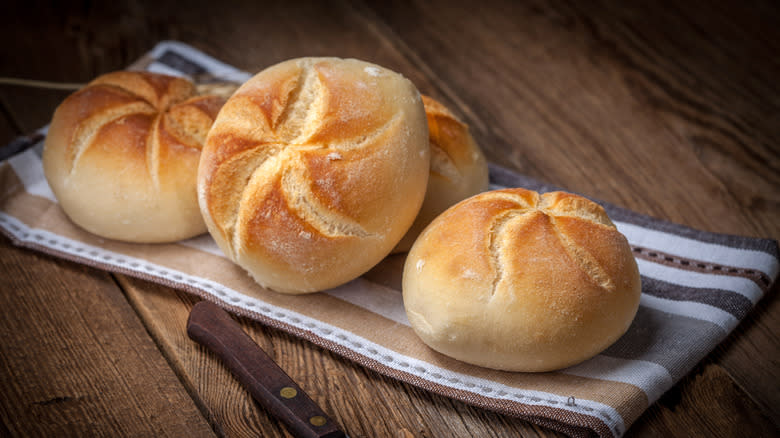
For those unfamiliar with the Kaiser or Vienna roll, this dense, crusty roll with a distinctive five-point crown-shaped pattern stamped upon its top side is a beloved vessel for sandwiches of all kinds. This yeast bread originated in Austria around 1760 and was named after the beloved monarch Kaiser Franz Joseph I. The basic recipe of this bread, known as Wiener Kaisersemmel (Handsemmel) in German, is codified under the Codex Alimentarius Austriacus, a type of regional code of standards for Austrian products.
Popular in delicatessens across eastern New York state and New Jersey, Kaiser or hard rolls are made in diverse sizes and can be plain or topped with seeds of various kinds, such as poppy, sesame, or sunflower. They are characterized by a chewy, firm, porous interior and a crunchy crust that tends to shatter when you bite into it. Its flavor is relatively neutral, with a mild yeasty aftertaste. This texture makes it perfect for moist, hearty, meaty breakfast sandwiches with fillings that can easily overwhelm other types of bread.
The key to working with a Kaiser roll is to use a good serrated knife to slice it in half and toast it, before topping it with your fillings of choice. While this type of bread is most often used for savory applications, its flavor is perfectly well-suited to sweet fillings, such as apricot jam and ricotta or goat cheese.
Bap
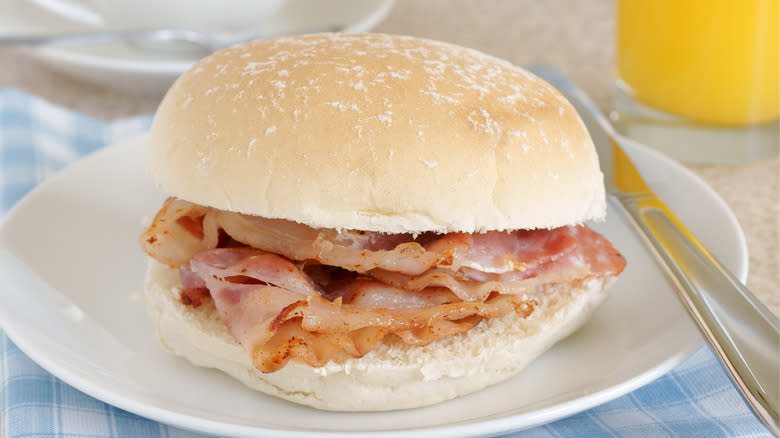
"Bap" is a name that describes a British breakfast sandwich that evolved during the Industrial Revolution, as well as the bread upon which this sammie is made. The bread, which hails from Scotland, is an enriched yeast bread made with copious quantities of lard that has undergone lengthy fermentation and is quite moist compared with standard bread dough. Baps were historically baked first thing in the day, garnering them the nickname "morning rolls." Typically placed upon high heat on the upper part of the oven, they would bake rapidly, yielding a pillowy texture and floury crust.
This unique texture and dainty size made a bap ideal for a breakfast sandwich. Once toasted, it could sop up the juices of fatty meats, runny egg yolks, and gooey cheese. Plus, they were the perfect size to neatly fit into one hand for ease of portability and consumption — the hallmark requirements for early breakfast sandwiches. Top your favorite breakfast sandwich with classic HP Sauce for authentic British flair. This umami-rich condiment made from vinegar, tomatoes, garlic, tamarind, and seasonings is a staple in the United Kingdom. It beautifully complements savory breakfast sandwiches of all kinds.
Focaccia
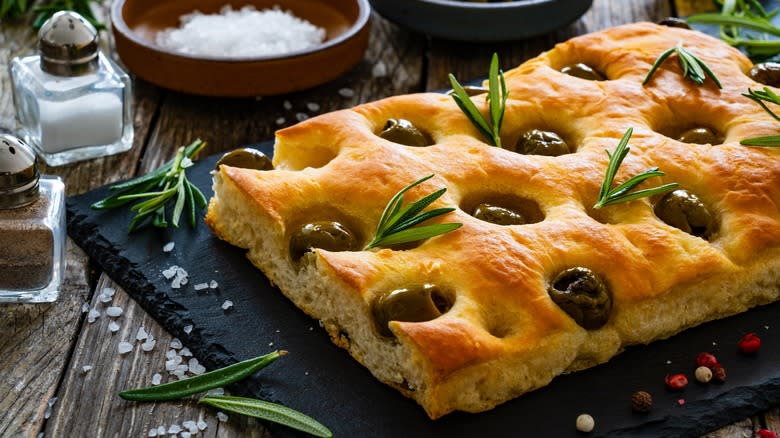
People often confuse focaccia with pizza. Though both are Italian delicacies, they are hardly the same. Focaccia is a type of yeast bread that, while similar to pizza, is leavened and shaped into a rectangle. The dough is fluffier and moister than pizza, with copious quantities of olive oil infused into and brushed atop the loaf. Before baking, this rectangular loaf is dimpled or dotted with pockets that give it an uneven crust. These dimples prevent air pockets from deflating the bread, keeping it light and spongy. Focaccia can be made plain or with toppings of various kinds ranging from vegetables and cheese to fruits and nuts.
A baked loaf of focaccia is typically around 1-inch thick, with a golden crust that has a marvelous chew without being overly dense. Its porous center is ideal for absorbing moist ingredients without falling apart, perfect for a breakfast sandwich. While olive oil is a prominent flavor, this by no means limits the utility of focaccia to savory breakfast sandwiches alone. It can easily be used for sweeter recipes, particularly when a high-quality fruity olive oil is used.
Crumpets
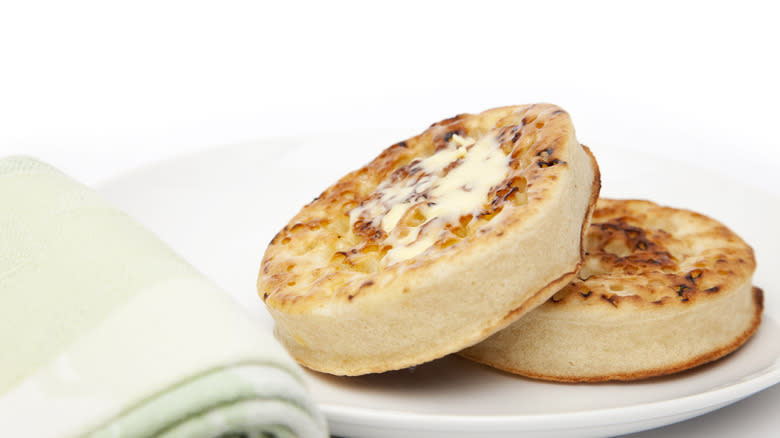
While baps may be the original bread used for a breakfast sandwich in Britain, another contender is equally as well-suited — the crumpet. While a crumpet may resemble an English muffin, it is quite different. The crumpet is of true British origin, while the English muffin was born in America. Both are produced on a skillet, are circular, and have unique nooks and crannies that are marvelous for sopping up juices.
They also differ in the basic dough used to make these breads. The crumpet is formed from a thinner batter that yields a more elastic texture. It is also only baked on one side, yielding a pancake-bread hybrid with cavities pockmarked along just one side of the crumpet, rather than permeating the entire finished product. For this reason, crumpets are usually served whole, rather than halved.
Using crumpets for a breakfast sandwich has many similar benefits to using English muffins -- including absorbency and a tender-yet-crisp texture when toasted. Crumpets are ideal for open-faced sandwiches, or you can use two crumpets, layering your favorite sweet or savory fillings between them.
Pan Cubano
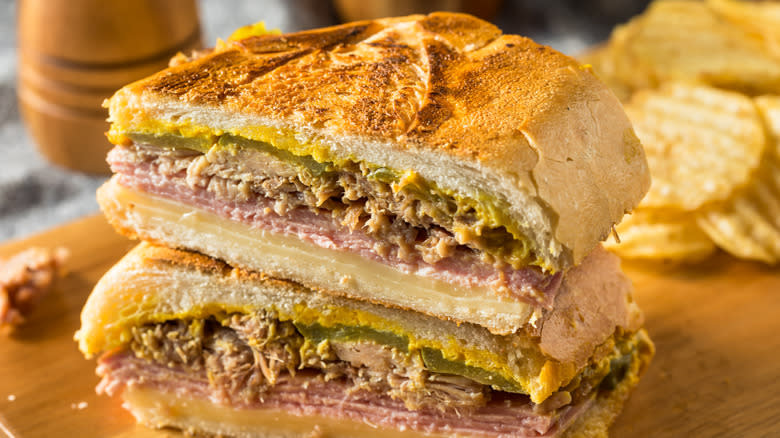
Though you may not associate a Cuban sandwich with breakfast, the melding of meat, pickles, mustard, and cheese layered atop a special kind of bread known as pan Cubano -- and heated together until the ingredients are oozing and the crust golden crisp -- is instructional for anyone seeking to elevate their breakfast sandwich game. The combination of ingredients makes this sandwich a powerhouse, but the bread is crucial to its success.
A pan Cubano is a specialty bread that resembles a baguette in shape and size. That is where the similarities end. It has a mild yet savory flavor with a thin, crisp, cracker-like crust and a pillowy, airy center that retains its softness even after heated, giving it maximum absorbency and an al dente mouthfeel.
The secret ingredient that sets this bread apart from others (and makes it a kindred spirit to many of the breads on this list) is the presence of lard in the dough. While variations are made with butter or shortening, they are nowhere near as flaky and lack a complexity of flavor that makes this bread ideal for breakfast sandwiches. Though you can use this bread for sweet or savory recipes, its unique profile makes it best suited for fatty meats, melted cheeses, runny eggs, and roasted or grilled vegetables.
Read the original article on Daily Meal

